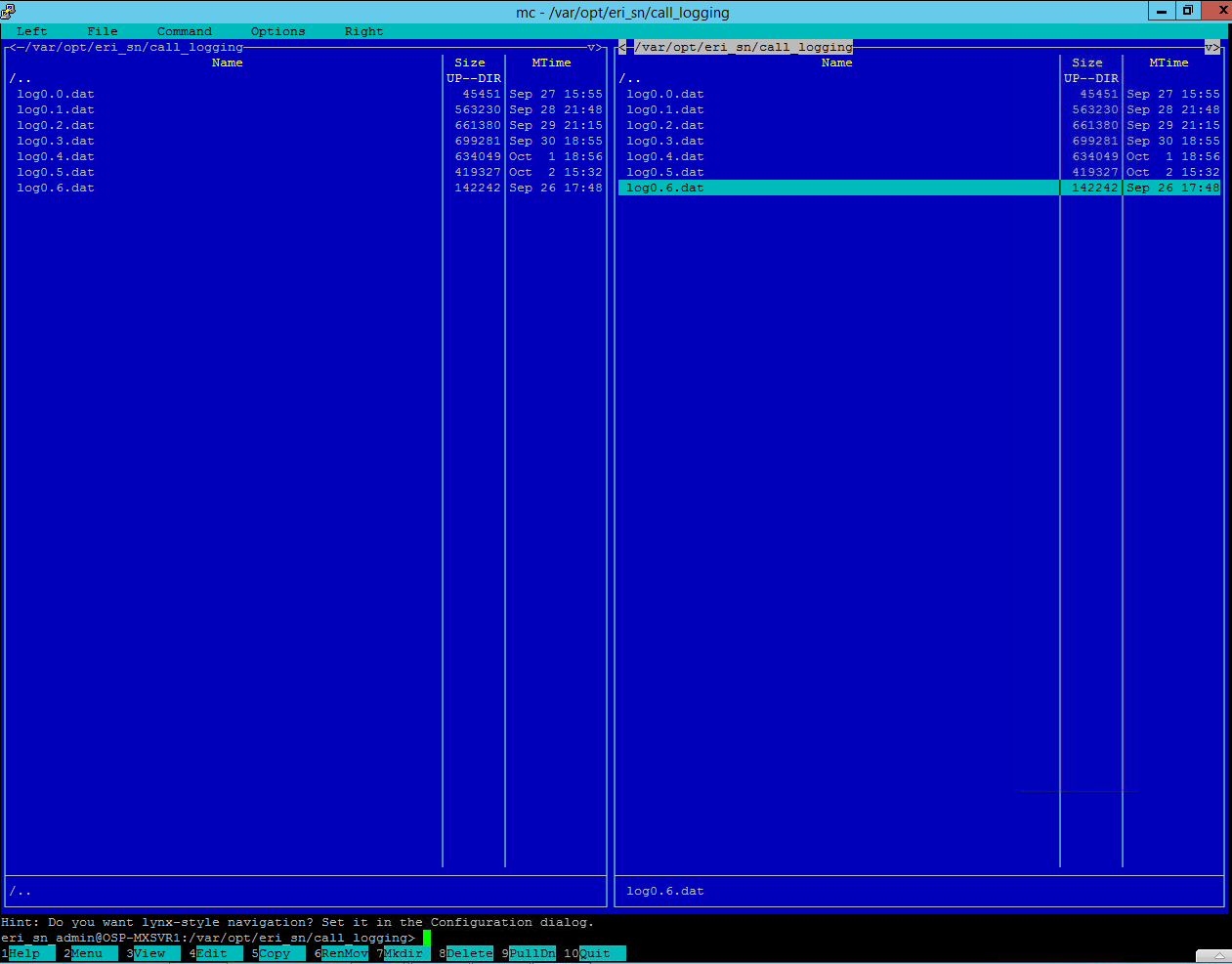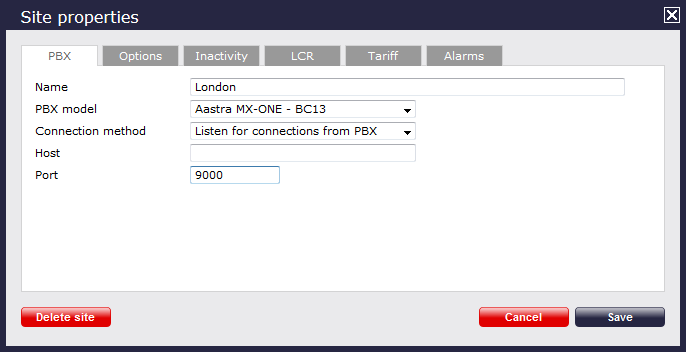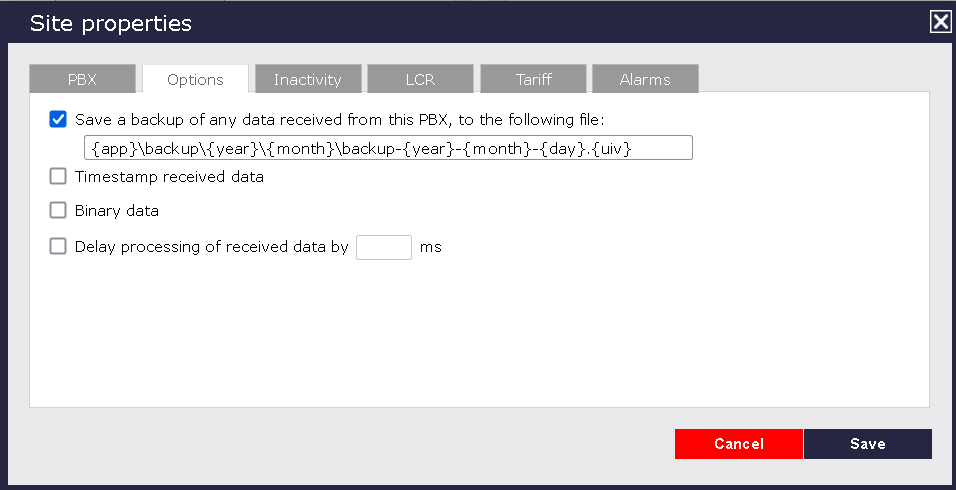Mitel Mi-Voice MX-ONE - IP connection
These instructions help you configure your Mite/Aastra MX-ONE - BC13 phone system to work with TIM Plus. Contact your system maintainer if you are not familiar with the configuration of your PBX.
Support files
Ensure the following support files exist in the /config/ folder of the TIM Plus application:
Aastra MX-ONE - BC13.TDS
Aastra MX-ONE - BC13.TDT
Contents
Configure the SMDR output
You may need to purchase a license to enable SMDR on this PBX. Please speak to your system maintainer if you are unsure.
The Mitel MX-One phone system saves the call logging information into a local database, located by default in:
/var/opt/eri_sn/call_logging

To edit the default path, SSH into each MX-One and use the mc command. To configure the directory structure, use the mkdir (key 7) command.
Next, you need to enter the following commands for the primary MX-One (the one that will send the data via IP to TIM Plus):
callinfo_output_set -output 0 -lim 1 -type file -subtype general -local -dbname /var/opt/eri_sn/call_logging/log0 -format ": {stoptime md110date L 4 4}{stoptime md110time L 4 4}{stoptime second 0R 2 2} {duration md110duration L 5 5}; [taxpulses != 0]: {taxpulses R 4 4}; [taxpulses == 0]: ; {conditionCodeUserDefined L 3 3} {accesscode1 R 5 5}{accesscode2 R 5 5}; [conditionCodePos == 17]: {chargedNumber R 20 20}; [conditionCodePos != 17]: {dialednumber R 20 20}; {callingnumber L 20 20} {accountcode L 15 15} {cilcode L 6 6} {queueTimeCounter 0R 3 3} {ringTimeCounter 0R 3 3} {ogTrnkId R 10 10} {incTrnkId R 10 10} {connectedNumber R 16 16}{return}{newline};" -eol NL -record call -localtime
callinfo_output_set -output 1 -lim 1 -type tcp -subtype general -server 192.168.0.1 -port 9000 -format ": {stoptime md110date L 4 4}{stoptime md110time L 4 4}{stoptime second 0R 2 2} {duration md110duration L 5 5}; [taxpulses != 0]: {taxpulses R 4 4}; [taxpulses == 0]: ; {conditionCodeUserDefined L 3 3} {accesscode1 R 5 5}{accesscode2 R 5 5}; [conditionCodePos == 17]: {chargedNumber R 20 20}; [conditionCodePos != 17]: {dialednumber R 20 20}; {callingnumber L 20 20} {accountcode L 15 15} {cilcode L 6 6} {queueTimeCounter 0R 3 3} {ringTimeCounter 0R 3 3} {ogTrnkId R 10 10} {incTrnkId R 10 10} {connectedNumber R 16 16}{return}{newline};" -eol NL -record call -localtime
The server IP address specified above will be the IP address of the TIM Plus machine. The port number can be set to any free TCP port, but we would recommend one in the 9000 range.
callinfo_output_set -output 2 -lim 1 -type file -subtype none -record call -utc
callinfo_output_set -output 3 -lim 1 -type file -subtype none -record call -utc
callinfo_output_set -output 4 -lim 1 -type file -subtype none -record call -utc
callinfo_output_set -output 5 -lim 1 -type file -subtype none -record call -utc
callinfo_output_set -output 6 -lim 1 -type file -subtype none -record call -utc
callinfo_output_set -output 7 -lim 1 -type file -subtype none -record call -utc
callinfo_output_set -output 8 -lim 1 -type file -subtype none -record call -utc
callinfo_output_set -output 9 -lim 1 -type file -subtype none -record call -utc
To send the data, add the following two commands for the primary MX-One:
callinfo_status_set -lim 1 -output 0 -state on
callinfo_status_set -lim 1 -output 1 -state on
For each additional MX-One in the cluster, the following commands need to be entered, applyinglim 2, 3, 4...n, accordingly.
callinfo_output_set -output 0 -lim 2 -type file -subtype general -local -dbname /var/opt/eri_sn/call_logging/log0 -format ": {stoptime md110date L 4 4}{stoptime md110time L 4 4}{stoptime second 0R 2 2} {duration md110duration L 5 5}; [taxpulses != 0]: {taxpulses R 4 4}; [taxpulses == 0]: ; {conditionCodeUserDefined L 3 3} {accesscode1 R 5 5}{accesscode2 R 5 5}; [conditionCodePos == 17]: {chargedNumber R 20 20}; [conditionCodePos != 17]: {dialednumber R 20 20}; {callingnumber L 20 20} {accountcode L 15 15} {cilcode L 6 6} {queueTimeCounter 0R 3 3} {ringTimeCounter 0R 3 3} {ogTrnkId R 10 10} {incTrnkId R 10 10} {connectedNumber R 16 16}{return}{newline};" -eol NL -record call -localtime
callinfo_output_set -output 1 -lim 2 -type file -subtype none -record call -utc
callinfo_output_set -output 2 -lim 2 -type file -subtype none -record call -utc
callinfo_output_set -output 3 -lim 2 -type file -subtype none -record call -utc
callinfo_output_set -output 4 -lim 2 -type file -subtype none -record call -utc
callinfo_output_set -output 5 -lim 2 -type file -subtype none -record call -utc
callinfo_output_set -output 6 -lim 2 -type file -subtype none -record call -utc
callinfo_output_set -output 7 -lim 2 -type file -subtype none -record call -utc
callinfo_output_set -output 8 -lim 2 -type file -subtype none -record call -utc
callinfo_output_set -output 9 -lim 2 -type file -subtype none -record call -utc
callinfo_status_set -lim 2 -forward 1 -state on
Configure TIM Plus
Follow the steps below to configure TIM Plus to listen for SMDR data from your Mitel Mi-Voice MX-One:
- Click on the
Directorytab. - If you don't have a site set up, press
Addand selectPBXfrom the drop-down menu. In the dialogue window, name your site and then selectAdd. - Locate the site object you want to configure in the Directory, click on it and select
Properties.
- In the Site Properties window, select Aastra MX-ONE - BC13 from the PBX model drop-down list.
- In the Connection method field, select Listen for connections from PBX from the drop-down list.
- Leave the Host field blank.
- In the Port field, enter the port number you have configured in the phone system.
- Click on the
Optionstab and tick the Keep a local backup of any data tickbox, as shown below
- Click on the
Savebutton to apply the settings.